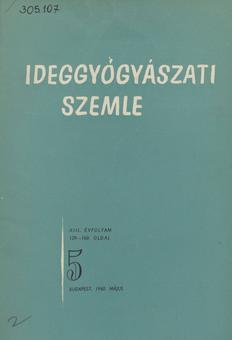The eLitMed.hu medical portal uses computer cookies for convenient operation. Detailed information can be found in the Cookie-policy.
Clinical Neuroscience - 1960;13(05)
Content
[Brainstem reflexes associated with temporal tumour]
[We report a case of brainstem syndrome associated with a right temporal tumour, partly as a reflex rhythm and partly of localisational significance.]
[Experiences and conclusions from using Hirepin]
[My experience with Hirepin in 22 patients and the conclusions I have drawn from it are summarised below: 1. the potential for parkinsonoid symptoms caused by Hibernal and Rausedyl to occur is increased when the two drugs are used together, which is otherwise desirable, and sometimes inhibits further effective treatment. 2. The use of Hirepin, while retaining the psychopharmacological benefits of Hibernal 4- Rausedyl, virtually eliminates the occurrence of parkinsonoid symptoms. 3. Hirepin has produced psychiatric improvement above the level of Hibernal 4- Rausedyl that causes parkinsonoid symptoms without the above symptoms, so parkinsonoid symptoms are not a necessary concomitant of psychiatric improvement, but are a necessary indicator of the individually effective level of medication.]
[Treatment of anaesthetic poisoning with beta-beta-methyl-ethyl glutarimide (Megimide) ]
[Authors report on the treatment of 13 patients with Megimide, mostly severe, some purely barbiturate, some combination intoxication. Megimide has the advantages of rapid onset of action, avoidance of side effects with careful dosing, and a very high therapeutic range of action. In our case, no toxic symptoms were observed with 1800 ml. ]
[Lessons learned from 200 Andaxin treatments]
[In half a year (first half of 1959) 200 patients were treated with Andaxin. Our experience has shown that Andaxin has an excellent effect in abnormal experiential reactions, especially when the premorbid personality does not show abnormal, "psychopathic" features; in the latter case it has a more favourable effect than Hibernal (chlorpromazine) and Rausedyl (rauwolfia), an important factor being that the side-effects are fewer and considerably milder. Another important aspect in outpatient psychiatry is that the drug is non-toxic, practically harmless and not suicidal. In schizophrenic patients, chlorpromazines are more effective, but combination with Andaxin seems preferable when the clinical picture (mainly defect syndromes) is dominated by anxious or hostile irritability, or when a parkinsonoid syndrome or akathisia-like obsessive-compulsive hyperkinesia has developed. Andaxin can be a useful adjunct to the treatment of chronic alcoholics, cerebro sclerotic patients and parkinsonism. It is likely to be most effectively used in combination with Tofranil for depression and with chlorpromazine for manic states. Side effects are few and harmless. These include "adynamia" at the start of treatment, mild allergic reactions in about 5% of cases and, finally, three cases of "loss of tone" which are not well understood.]
[Operated intracerebral haemorrhages]
[In addition to a brief review of the literature on intracerebral haemorrhages and their surgical management, we described the clinical and surgical management of 12 cases. The clinical picture is characterized by acute onset and bloody or xantochromic cerebrospinal fluid, the development of nodal symptoms and progressive intracranial pressure increase, which may be pathognomic for apoplexy in the case of advanced age and hypertension, otherwise most often for haemorrhage from cerebral haemorrhage, the latter especially when paroxysmal phenomena are present before the acute onset. The cause of bleeding in our cases was, according to the literature, hypertension, angioma, aneurysm, trauma and unknown cause. The surgical solution consisted of aspiration of the haemorrhage or excision of the hemorrhage from the capsule and, where possible, resolution of the occult lesion. Of 12 patients, none were lost after surgery and the outcome was satisfactory in 11 cases. Our conclusion on the question of surgery for non-hypertensive haemorrhages is the same as the general principles, but for hypertensive haemorrhages it avoids any generalised constraint on the choice of time. ]
1.
Clinical Neuroscience
[Headache registry in Szeged: Experiences regarding to migraine patients]2.
Clinical Neuroscience
[The new target population of stroke awareness campaign: Kindergarten students ]3.
Clinical Neuroscience
Is there any difference in mortality rates of atrial fibrillation detected before or after ischemic stroke?4.
Clinical Neuroscience
Factors influencing the level of stigma in Parkinson’s disease in western Turkey5.
Clinical Neuroscience
[The effects of demographic and clinical factors on the severity of poststroke aphasia]1.
2.
3.
4.
5.



